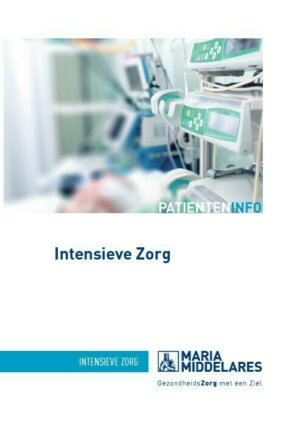What do we do?
Yourself or a family member has been admitted to our Intensive Care Department. This complex department can be quite overwhelming. We would therefore like to give you a bit more explanation to help you become more familiar with the environment.
Patient monitoring
Patient monitoringAt the Intensive Care Department, we firstly monitor the vital functions of the bodies of seriously ill patients of patients who threaten to develop a life-threatening problem. To this end, we use several different monitoring techniques. Some of our monitoring techniques do not or hardly interfere with your bodily integrity. Examples of these are electrocardiogram (measures the electrical activity of the heart), pulse oximetry (measures the oxygen level in the blood), ultrasound (imaging using high frequency sound waves) and non-invasive blood pressure measuring (measures blood pressure using a cuff around your arm).
If the situation is serious, these non-invasive monitoring methods no longer suffice. In that case, we make use of monitoring techniques that interfere with the bodily integrity as little as possible, such as:
- An arterial catheter
- A central venous catheter
- A Swan-Ganz catheter
- An ultrasound of the heart via the oesophagus
- A bronchoscopy
Treatment of patients
Treatment of patientsIt is not only monitoring that is important at the Intensive Care Department. Critically ill patients very often require treatment that, in less critical circumstances, patients are asked by the physician to consent to at the point of implementation. During a life-threatening situation, we may not have the opportunity to discuss what we plan to do first. The most commonly used treatments at the Intensive Care Department are as follows:
- Administration of medication by mouth or through the bloodstream
- Placing of a central venous catheter
- Placing of an intra-aortic balloon pump
- Administration of blood and blood products
- Placing of a chest drain
- Artificial ventilation
- Reanimation
- Dialysis at the Intensive Care Department
- Placing of a urinary catheter
- Placing of a stomach catheter
- Placing of a Flexi-Seal in case of severe diarrhoea
To limit the risk of falling, special attention is paid to the use of side rails and overbed tables.
At the Intensive Care Department, patients may occasionally be confused and agitated. In such circumstances, it may be necessary to protect patients from themselves. In order to register these occurrences as accurately as possible, they are kept track of. If necessary, patients are started on medication to control their agitation. If this proves insufficient and their agitation endangers the patient or the patient’s treatment, the patient may be secured. We call this restraint.
Important to know
Important to knowYour first visit to our department can be confronting because your relative is surrounded by equipment and fitted with a variety of tubes, bandages and stickers. Patients may also have a tube in the throat to help them breathe. This means that she or he is unable to speak. Please feel free to hold your relative’s hand or give them a kiss, or try to speak to them even if they can’t answer.
Please indicate if you require additional support.
You will notice that the equipment at the Intensive Care Department will produce different alarms. These alarms do not necessarily mean that something is going wrong or that you are doing something wrong. The nurse will note the alarm and always react, if necessary.
Design of a room (box) at the Intensive Care Department
Design of a room (box) at the Intensive Care DepartmentAs you and your family will have a lot to process, we want to give you a brief impression of what a box (room) at the Intensive Care Department looks like.
- Continuous cuff pressure gauge: device to keep the balloon at the end of the tube adequately inflated.
- Feeding pump: pump to safely deliver feed.
- Aspiration device: device for the nurse to remove mucous from the tube or mouth.
- Subglottic aspiration device: device that allows for the occasional removal of secretions from above the cuff.
- Infusion pumps: devices used to administer medication and fluids in a safe, controlled manner.
- Monitor: the screen that displays the values of the critical parameters. If certain threshold values are exceeded, the device will produce an (audible) alarm. A member of staff will note that signal.
- Ventilation device: device to support the patient’s breathing.
- Bedside PC: the computer where the nurse enters all data and orders.
Leaflet
LeafletAll information above can also be reviewed in our leaflet:
Only available in Dutch:

Intensieve zorg AZ Maria Middelares
Download


